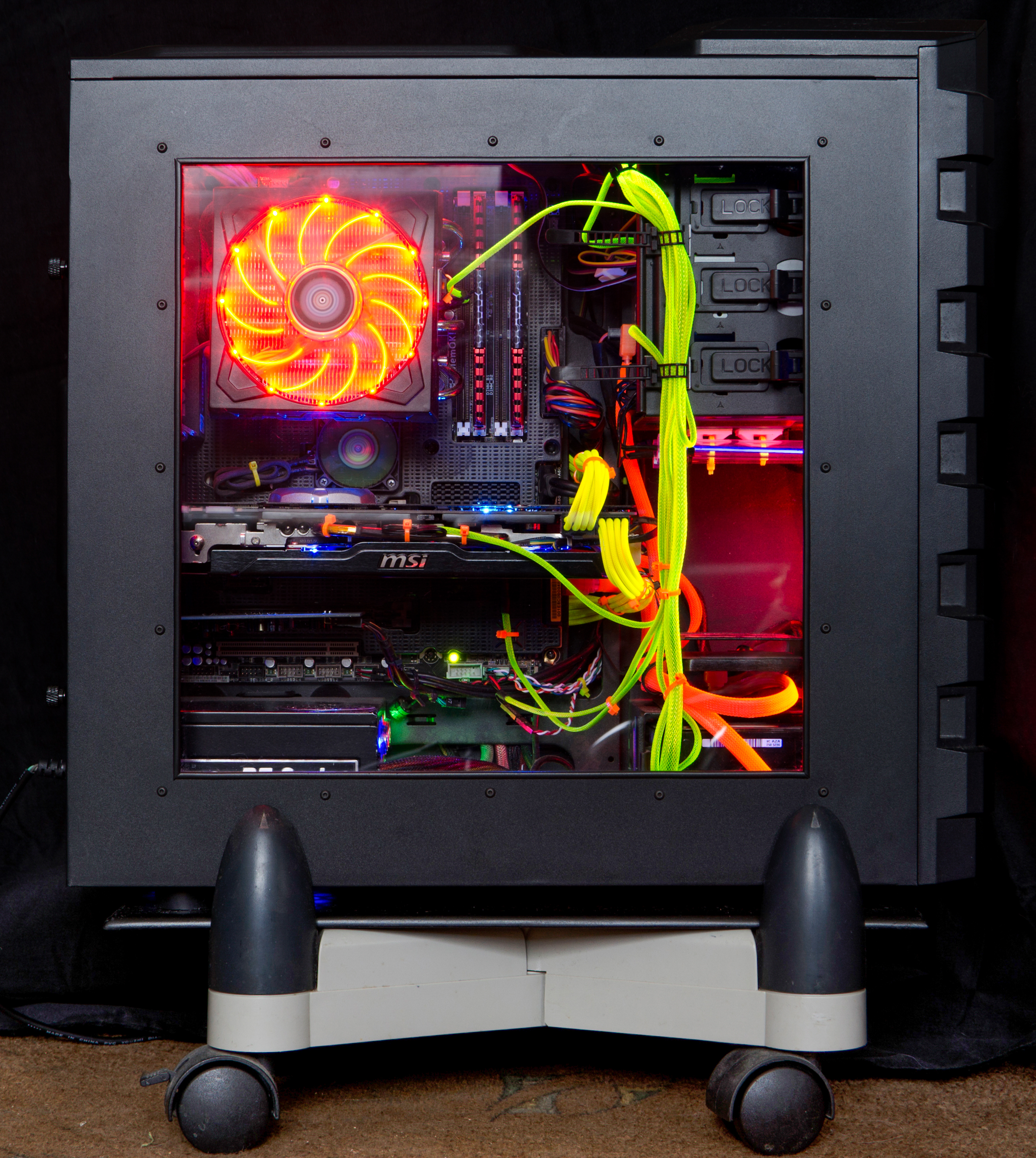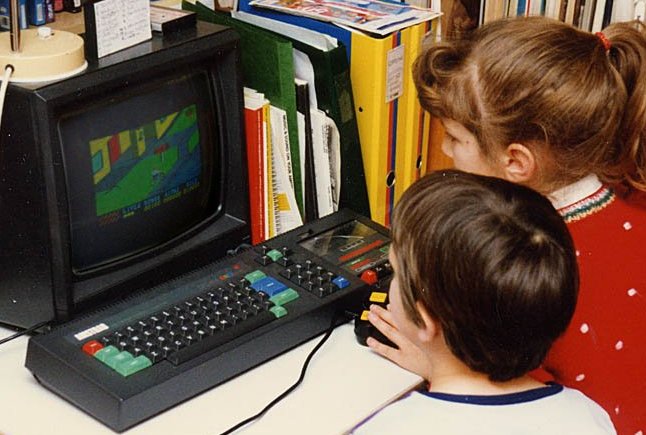|
Intel 8255
The Intel 8255 (or i8255) Programmable Peripheral Interface (computer science), Interface (PPI) chip was developed and manufactured by Intel in the first half of the 1970s for the Intel 8080 microprocessor. The 8255 provides 24 parallel input/output lines with a variety of programmable operating modes. The 8255 is a member of the Intel 8085#MCS-85 family, MCS-85 family of chips, designed by Intel for use with their Intel 8085, 8085 and Intel 8086, 8086 microprocessors and their descendants. It was first available in a 40-pin Dual in-line package, DIP and later a 44-pin Plastic leaded chip carrier, PLCC packages. It found wide applicability in digital processing systems and was later cloned by other manufacturers. The 82C55 is a CMOS version for higher speed and lower current consumption. The functionality of the 8255 is now mostly embedded in larger Very-large-scale integration, VLSI processing chips as a sub-function. A CMOS version of the 8255 is still being made by Renesas El ... [...More Info...] [...Related Items...] OR: [Wikipedia] [Google] [Baidu] |
Western Design Center
The Western Design Center (WDC), located in Mesa, Arizona, is a company that develops intellectual property for, and licenses manufacture of, MOS Technology 65xx based microprocessors and microcontrollers. WDC was founded in 1978 by a former MOS Technology employee and co-holder of the MOS Technology 6502 patent, Bill Mensch. Prior to leaving MOS Technology in 1977 Bill was the microprocessor design manager at MOS Technology. Beyond discrete devices, WDC offers device designs in the form of semiconductor intellectual property cores (IP cores) to use inside other chips such as application-specific integrated circuit (ASICs), and provides ASIC and embedded systems consulting services revolving around their processor designs. WDC also produces C compilers, assembler/linker packages, simulators, development–evaluation printed circuit boards, and in-circuit emulators for their processors. Hardware products The first product developed by WDC was the WDC 65C02, a CMOS version ... [...More Info...] [...Related Items...] OR: [Wikipedia] [Google] [Baidu] |
N8VEM
N8VEM was a homebrew computing project created in 2008 by Andrew Lynch. It featured a variety of free and open hardware and software. N8VEM builders made their own homebrew computer systems for themselves and shared their experiences with other homebrew computer hobbyists. N8VEM homebrew computer components are made in the style of vintage computers of the mid to late 1970s and early 1980s using a mix of classic and modern technologies. They are designed with ease of amateur assembly in mind. In November 2015, Lynch ended the N8VEM project, and the community reconvened under the new name of Retrobrew Computers. Creation and operation There are several N8VEM designs starting with a single-board computer carrying a Zilog Z80 microprocessor designed to run CP/M and similar operating systems. Contrasted with the P112, which has some surface-mount components, the N8VEM SBC uses only through-hole components, consistent with the design philosophy that building should be within the skill ... [...More Info...] [...Related Items...] OR: [Wikipedia] [Google] [Baidu] |
Homebuilt Computer
A custom built or home-built computer is a computer assembled by its user and made of commercial off-the-shelf (COTS) components, rather than purchased as a complete and ready to use machine, also known as a "pre-built" or out-of-the-box system. Building a computer at home is generally considered a cost-effective alternative to buying a pre-built one because it excludes the assembly labor cost. However, the total cost of building a computer can vary based on an individual's budget, the quality and availability of the parts used, and the discounts offered by mass production. As a result, the final cost may potentially exceed that of typical pre-built computers. Home-built computers are often used at home, like home computers, but home computers are traditionally purchased already assembled by the manufacturer. Some suppliers provide both home and homebuilt computers, like the Newbear 77-68, which the owner was expected to assemble and use in their home. History Mechanical (no ... [...More Info...] [...Related Items...] OR: [Wikipedia] [Google] [Baidu] |
IBM-PC
The IBM Personal Computer (model 5150, commonly known as the IBM PC) is the first microcomputer released in the IBM PC model line and the basis for the IBM PC compatible ''de facto'' standard. Released on August 12, 1981, it was created by a team of engineers and designers at International Business Machines (IBM), directed by William C. Lowe and Philip Don Estridge in Boca Raton, Florida. Powered by an x86-architecture Intel 8088 processor, the machine was based on open architecture and third-party peripherals. Over time, expansion cards and software technology increased to support it. The PC had a substantial influence on the personal computer market; the specifications of the IBM PC became one of the most popular computer design standards in the world. The only significant competition it faced from a non-compatible platform throughout the 1980s was from Apple's Macintosh product line, as well as consumer-grade platforms created by companies like Commodore and Atari. Most ... [...More Info...] [...Related Items...] OR: [Wikipedia] [Google] [Baidu] |
SV-328
The SV-328 is an 8-bit home computer introduced by Spectravideo in June 1983. It was the business-targeted model of the Spectravideo range, sporting a compact full-travel keyboard with numeric keypad. It had 80 KB Random-access memory, RAM (64 KB available for software, remaining 16 KB video memory), a respectable amount for its time. Other than the keyboard and RAM, this machine was identical to its little brother, the SV-318. The SV-328 is the design on which the MSX standard was based. Spectravideo's MSX-compliant successor to the 328, the SV-728, looks almost identical, the only immediately noticeable differences being a larger cartridge slot in the central position (to fit MSX standard cartridges), lighter shaded keyboard and the MSX badging. Reference to the operating system Microsoft BASIC, Microsoft Extended BASIC is not to be confused with MSX BASIC, although some marketing at the time claimed that Microsoft Extended is what MSX stood for. More than 130 ga ... [...More Info...] [...Related Items...] OR: [Wikipedia] [Google] [Baidu] |
Home Computer
Home computers were a class of microcomputers that entered the market in 1977 and became common during the 1980s. They were marketed to consumers as affordable and accessible computers that, for the first time, were intended for the use of a single, non-technical user. These computers were a distinct market segment that typically cost much less than business, scientific, or engineering-oriented computers of the time, such as those running CP/M or the IBM PC, and were generally less powerful in terms of computer memory, memory and expandability. However, a home computer often had better video display controller, graphics and sound than contemporary business computers. Their most common uses were word processing, playing video games, and computer programming, programming. Home computers were usually sold already manufactured in stylish metal or plastic enclosures. However, some home computers also came as commercial electronic kits, like the ZX80, Sinclair ZX80, which were both h ... [...More Info...] [...Related Items...] OR: [Wikipedia] [Google] [Baidu] |
Tesla (Czechoslovak Company)
TESLA a.s. is a Czech manufacturer and supplier of special radio communication and security electrical engineering for military and commercial use. The name was originally used by a state-owned conglomerate that was the monopoly producer of electronic appliances and components in the former Socialist Republic of Czechoslovakia. The conglomerate was founded in 1946 and ran until 1991, when it was privatised. The Tesla name is used by its successor company and former subsidiaries in the Czech Republic and Slovakia. In 2011, the Czech company Inter-Sat Ltd. acquired the license for the Tesla brand name from TESLA a.s. to sell household appliances and consumer electronics with different logo in Europe, mostly in Central and Southeastern countries. Company The company was established as ''Elektra'' on 18 January 1921 and renamed Tesla on 7 March 1946. A founding ceremony took place on 10 August 1946 at the Mikrofon Factory in Strašnice attended by government ministers from Cz ... [...More Info...] [...Related Items...] OR: [Wikipedia] [Google] [Baidu] |
KR580VM80A
The KR580VM80A () is a Soviet microprocessor, a clone (computer science), clone of the Intel Intel 8080, 8080 CPU. Different versions of this CPU were manufactured beginning in the late 1970s, the earliest known use being in the SM EVM, SM1800 computer in 1979. Initially called the K580IK80 (К580ИК80), it was produced in a 48-pin planar process, planar metal-ceramic package. Later, a version in a Dual in-line package, PDIP-40 package was produced and was named the KR580IK80A (КР580ИК80А). The pin layout of the latter completely matched that of Intel's Intel 8080, 8080A CPU. In 1986 this CPU received a new part number to conform with the 1980 Soviet integrated circuit designation and became known as the KR580VM80A (КР580ВМ80А), the number it is most widely known by today (the KR580VV51A and KR580VV55A peripheral devices went through similar revisions). Normal clock frequency for the K580IK80A is 2 MHz, with speeds up to 2.5 MHz for the KR580VM80A. The KR580IK8 ... [...More Info...] [...Related Items...] OR: [Wikipedia] [Google] [Baidu] |
Chip Carrier
In electronics, a chip carrier is one of several kinds of surface-mount technology packages for integrated circuits (commonly called "chips"). Connections are made on all four edges of a square package; compared to the internal cavity for mounting the integrated circuit, the package overall size is large.Kenneth Jackson, Wolfgang Schroter, (ed), ''Handbook of Semiconductor Technology Volume 2'', Wiley VCH, 2000, , page 627 Types Chip carriers may have either J-shaped metal leads for connections by solder or by a socket, or may be lead-less with metal pads for connections. If the leads extend beyond the package, the preferred description is " flat pack". Chip carriers can be smaller than dual in-line packages and since they use all four edges of the package they can have a larger pin count. Chip carriers may be made of ceramic or plastic. Some forms of chip carrier package are standardized in dimensions and registered with trade industry associations such as JEDEC. Other forms a ... [...More Info...] [...Related Items...] OR: [Wikipedia] [Google] [Baidu] |
Oki Electric Industry
, commonly referred to as OKI, OKI Electric or the OKI Group, is a Japanese information and communications technology company, headquartered in Toranomon, Minato-ku, Tokyo and operating in over 120 countries around the world. OKI produced the first Japan-made telephone in 1881, and now specializes not only in developing and manufacturing telecommunications equipment but also in information products and mechatronics products, such as automated teller machine (ATMs) and printers. OKI had a semiconductor business, which it spun off and sold to Rohm Company, Limited on October 1, 2008. OKI Data, a subsidiary, which markets its products under the OKI brand, is focused on creating professional printed communications products, applications and services. OKI Data provides a wide range of devices, from printers, faxes and multi-functional products to business applications and consultancy services. Through its American business arm, OKI Data America markets the OKI proColor Series, a ... [...More Info...] [...Related Items...] OR: [Wikipedia] [Google] [Baidu] |







